Douglas Southern Electric Tramways
History
The history of Douglas Southern Electric Tramways was intimately bound up with that of the Douglas Head Marine Drive Company, along whose drive the tramway was ultimately laid. The drive was first opened in 1891, but was initially plagued by financial mismanagement, only reaching its ultimate destination — Port Soderick — in 1897. Although still troubled by a lack of capital, by 1893 the company had announced plans to construct a tramway along the drive; this did not require an act of parliament as the entire line was to be laid on private land. The concession to build and operate the tramway now passed through a series of hands, each no doubt profiting from the transaction; the first of these — on the 6th November 1894 — were two major DHMDCo shareholders (Lowcock and Hill, electrical engineers of Old Trafford). Barely one month later — on the 10th December 1894 — Lowcock and Hill made a private agreement with the Electric and General Contract Corporation, which had been founded two years earlier by the pioneering American electrical engineer, William Sebastian Graff Baker, to sell the concession, which they duly did four months later on the 10th April 1895. The E&GCC held the concession for a mere three weeks before selling it to a new company — the General Traction Company — on the 22nd April 1895; the GTCo was in fact another of Graff Baker's companies, which he had only registered one month before on the 20th March 1895. This bewildering round of transfers still had some way to run, another new entity — Douglas Southern Electric Tramways Limited — being set up on the 21st October 1895, to which the concession (by now for 30 years) was transferred in February 1896.
Meanwhile, construction of the standard-gauge, overhead electric tramway had commenced (on either the 30th December 1895 or the 13th January 1896, depending which source is to be believed). It was built on the single-line and loop principle, and ran broadly southwestwards from a terminus near Douglas Head, through the Marine Drive tollgates, then high above the sea along the coast via Pigeon Stream (the location of the power house), Port Walberry, Horse Leap, Little Ness (the location of the depot), the Whing, Rebog and Keristal to Port Soderick. The line was notable for its three tall lattice-girder viaducts at Pigeon Stream (117ft), Walberry (256ft) and Horse Leap (120ft). The line opened to the public as far as the Whing on the 7th August 1896, and to Keristal on the 7th September. The final section to Port Soderick was opened on the 1st April 1897. The final tramway was 3.25 miles long.
Before it opened, ownership of the DSETCo changed hands yet again when its parent company — the General Traction Company — transferred its tramway assets and concessions to a new company that had been expressly set up for that purpose, the New General Traction Company (registered on the 24th March 1896). This restructuring appears to have been driven by a New York Bank, which had purchased all Graff Baker's GTCo shares in February 1896. The New General Traction Company would eventually own two additional electric-tramway systems on the mainland, which it operated via the Coventry Electric Tramways Company (opened on the 4th December 1895) and the Norwich Electric Tramways Company (opened on the 30th July 1900).
The tramway was an immediate success, proving very popular, such that the DSETCo was able to pay respectable dividends, despite having to hand over 5% of its receipts (plus a toll per passenger) to the DHMDCo. The service was always seasonal, but was brought to an abrupt end in August 1914 by the outbreak of the Great War. The company had clearly not accrued much in the way of reserves as it was forced to borrow money during the war, presumably for care and maintenance, even though the tramway was not running. Following the conclusion of the conflict, the tramway overhead was completely renewed, as well as much other work, all of it being paid for out of revenue.
Following a brief post-war boom, passenger numbers gradually declined over the course of the 1920s, though the tramway still made a reasonable profit. In 1926, when the DSETCo's concession expired, the company was effectively merged with the DHMDCo, the NGTCo selling its subsidiary to the latter; although the transfer took place on the 3rd April 1926, it had in fact been agreed as far back as 1921. The tramway continued to operate as before, but from 1929 onwards it suffered from motorbus competition, which though not allowed on the Marine Drive, still extracted passengers who were happy to go the long way round to Port Soderick.
By 1932, the tramway was making a loss and throughout the 1930s it struggled to break even, let alone provide for renewals. The tramway closed early for the winter of 1939 due to the outbreak of the Second World War. The last tram ran on the 15th September 1939, though unbeknownst to all involved, it was in fact destined never to reopen. The DHMDCo entered receivership in 1946, and was dissolved on the 12th January 1948. The company's assets were sold to the Isle of Man Highway and Transport Board, one tramcar being saved for posterity.
Uniforms
Fortunately, an excellent staff photograph has survived that was very probably taken around the time of opening or perhaps the year after. This clearly shows that motormen and conductors wore double-breasted jackets with four pairs of metal buttons (of unknown pattern), and lapels; the jackets were completely devoid of insignia. The peaked caps were soft topped, as opposed to having a tensioned crown, and bore a material peak; they carried an embroidered hat band that appears not to have borne a badge of any kind, at least not one that can be made out on the surviving photographs. The general style of jacket appears to have remained unchanged right through to the mid 1930s, with only the cap changing — at some point — to a tensioned crown type, again without a badge of any kind. In the mid 1930s, however, the jackets were changed to a pattern — still double-breasted and with lapels — but with three pairs of unreflective buttons, suggesting that the latter were not metal. It is entirely possible that these later uniforms were simply lounge suits, as they do not have a robust look to them.
Surviving records suggest that during the late-Edwardian era, the company employed nine crew pairs (presumably nine motormen and nine conductors), along with three inspectors, a car-shed foreman and a traffic superintendent.
Inspectors wore identical jackets and caps to those issued to tramcar crews, except for a cap badge, which was probably cloth and included a wreath; the latter certainly bore something in its centre, possibly system initials or a symbol of some kind, though this cannot unfortunately be made out on the surviving photographs.
Tramway services were suspended throughout the Great War, so the DSET never employed female staff.
Further reading
For more information on the DSET, see: 'Douglas Head Marine Drive and Electric Tramway' by A M Goodwyn; and 'Double Century' by Stan Basnett and Keith Pearson; Adam Gordon Publishing (1996).
Images
Motormen and conductors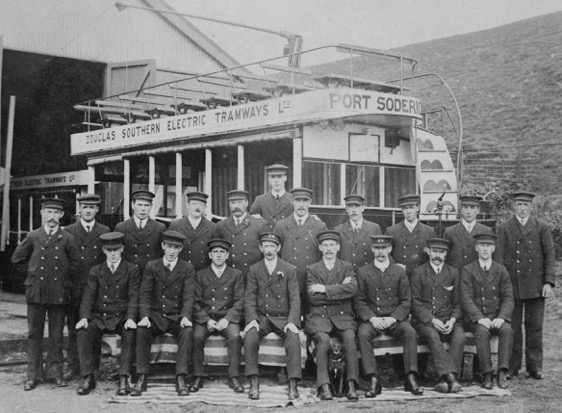
A rare photograph of what is almost certainly the entire uniformed staff of the DSETCo, lined up for the cameraman at the depot at Little Ness. Although undated, it seems likely that it was taken around the time of the initial opening or the full opening to Port Soderick, i.e., 1896 or 1897. Photo courtesy of the National Tramway Museum. 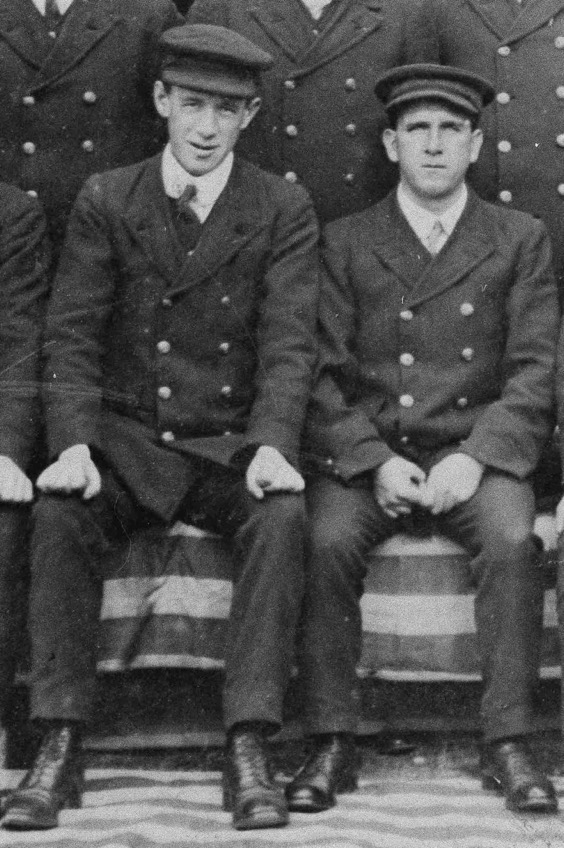
An enlargement of the above photograph showing two of the men, presumably either conductors or motormen. The uniform appears to be completely devoid of badges, and even the soft-topped caps appear to have an embroidered hat band without a badge or grade designation of any kind.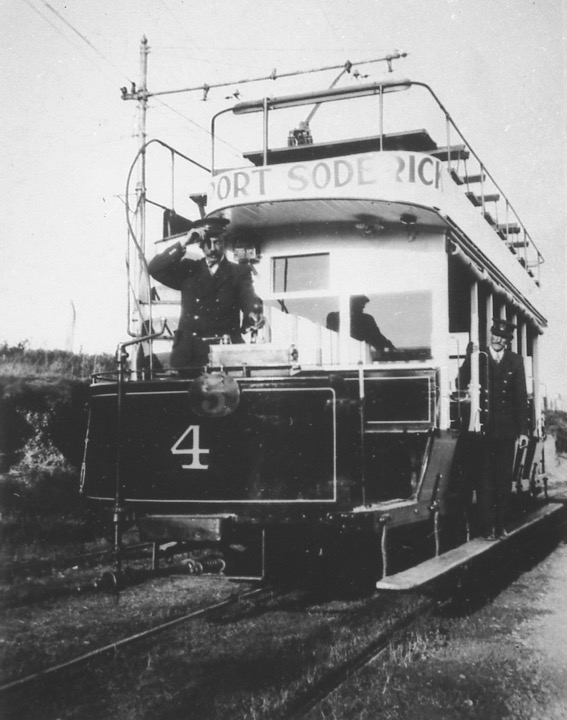
A motorman and an inspector (on the running board) with Tramcar No 4 — photo undated, but probably taken in the early 1930s. The disc ('No 5'), which was placed on the dash by the inspector, indicates that there were five tramcars in operation. The location is uncertain, but may have been 'The Farm' loop. Photo courtesy of the Tramways and Light Railway Society, with thanks to David Voice.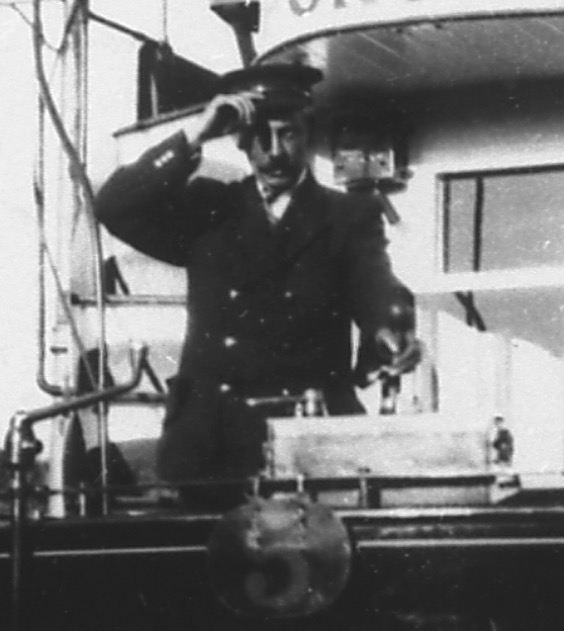
An enlargement of the above photograph showing the motorman, whose cap is plain, i.e., without a cap badge. The buttons, in contrast to the following photo, would appear to be metal.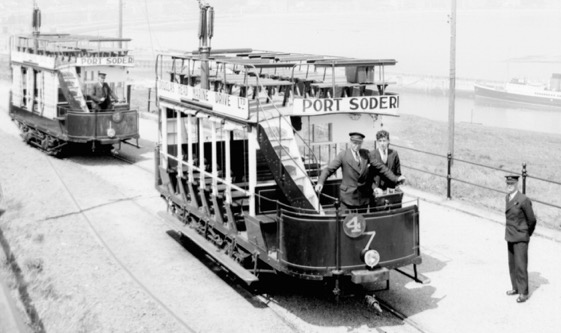
Douglas Head Marine Drive Company tramcars (No 1 and No 7) at Douglas Head on the 30th May 1939. Photo by W A Camwell, courtesy of the National Tramway Museum. 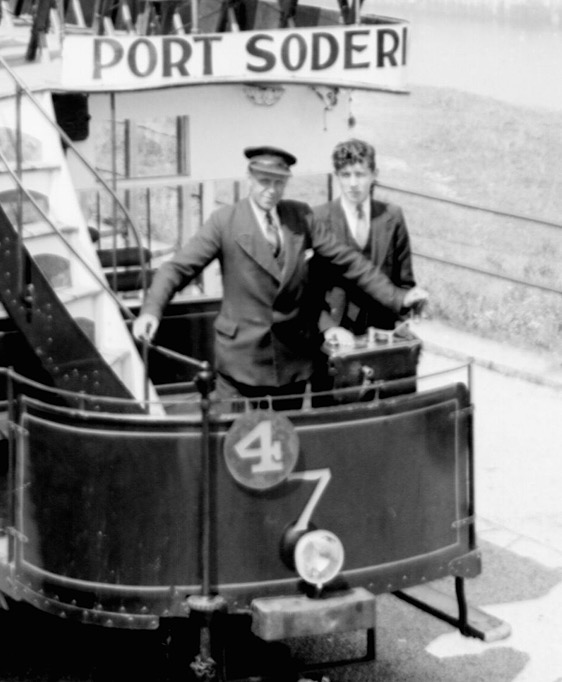
An enlargement of the above photograph showing the motorman of Tramcar No 7 — Bobby Moore — in an almost lounge-suit-like uniform with plain, non-metallic buttons, and totally devoid of insignia.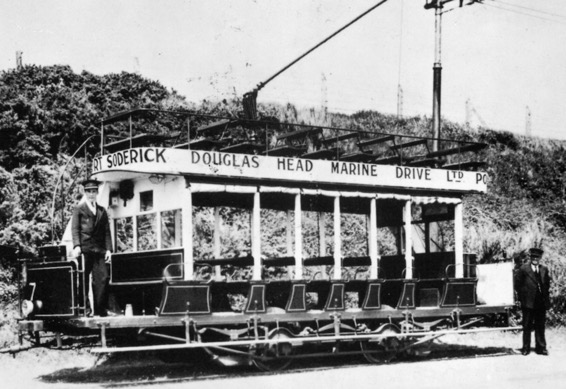
A conductor and a motorman with Tramcar No 7 — photo undated, but certainly taken no earlier than 1936, when headlamps were fitted to the cars. Photo courtesy of the Tramways and Light Railway Society, with thanks to David Voice.
Senior staff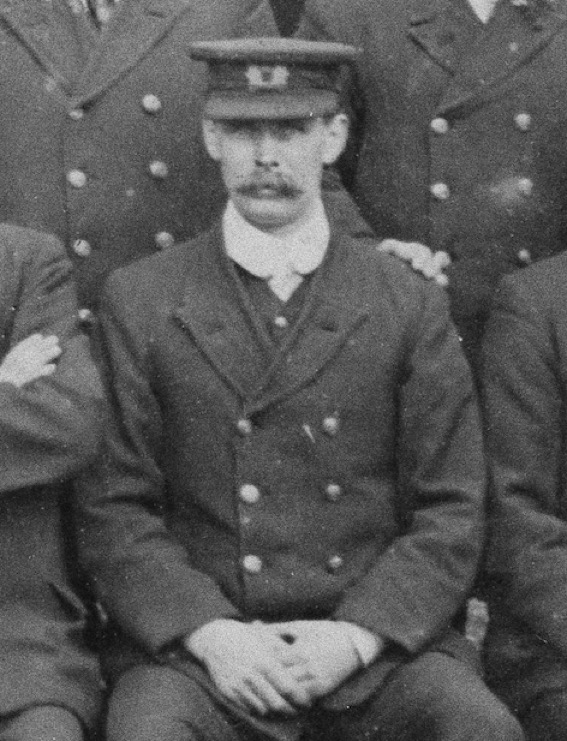
An enlargement of the Victorian staff photograph above showing one of the two inspectors. His uniform is identical to those worn by the tramcar staff, other than for a cap badge, which would appear to be of embroidered cloth, with either initials or a symbol inside a wreath.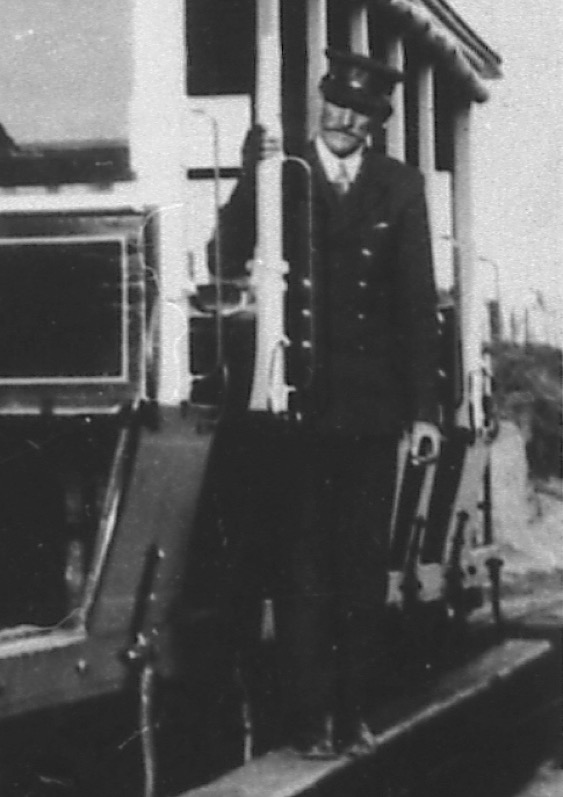
A blow-up of the early 1930s shot of Tramcar No 4 above, showing a figure who is almost certainly an inspector. His cap bears the same type of badge as seen in the Victorian shot above.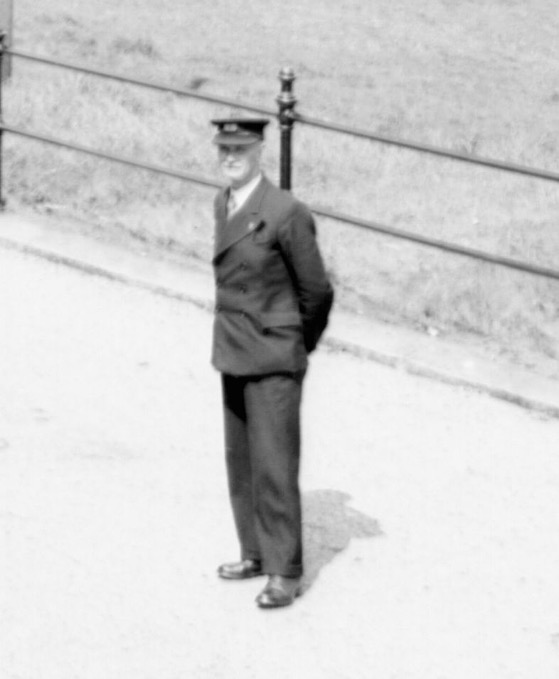
An enlargement of the 1939 W A Camwell shot above showing Chief Inspector Harold Colquitt. He is wearing a plain, lounge-suit-like uniform, seemingly identical to that worn by the motorman in the same photograph.